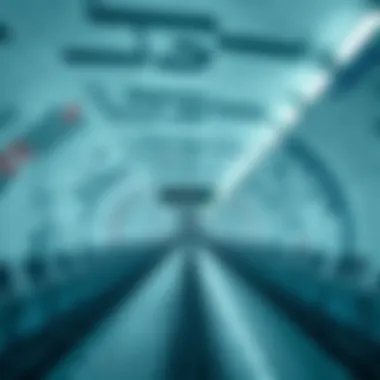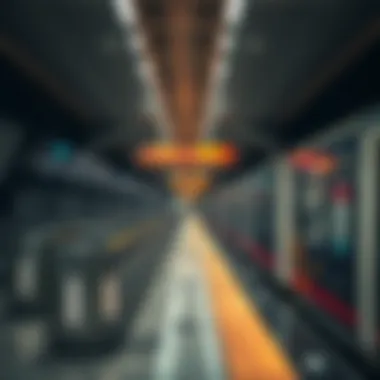Exploring Dubai's Metro Map: A Comprehensive Guide


Intro
Navigating the vast and bustling city of Dubai could feel like trying to find a needle in a haystack, especially for newcomers. However, with the advent of Dubai's metro system, moving around the city has never been simpler. The metro is more than just a means of transportation; it serves as a lifeline connecting various districts, attracting residents, tourists, and businesses alike. From the gleaming skyscrapers of Downtown to the expansive malls in Dubai Marina, understanding the intricacies of the metro system can elevate your experience in this dynamic metropolis.
The intent of this article is not just to guide you through the lines and stations of the Dubai Metro but to illustrate its significance in shaping the urban landscape. Beyond simple commutation, the metro is deeply intertwined with the property market and urban development. As we delve into this exploration, it’s crucial to note how proximity to metro stations can influence real estate values and urban planning strategies for the future.
The subsequent sections will offer detailed insights into the property market; current trends will be examined, along with key neighborhoods that are thriving due to the metro's presence. Additionally, we will provide practical guidelines for potential investors and those interested in buying or selling properties within this vibrant ecosystem. With the world-changing rapidly around us, understanding how to navigate not only the metro map but also the property landscape is imperative for making informed decisions.
Overview of Dubai's Metro System
Dubai's Metro system stands as a hallmark of modern urban transport, bridging the gap between different parts of a rapidly expanding metropolis. Not only does it facilitate ease of movement, but it also embodies the emirate's commitment to sustainability and innovation. As Dubai continues to thrive, understanding the metro system is crucial for a variety of stakeholders including investors, buyers, agents, developers, and sellers in the real estate market.
The architecture of the metro reflects a seamless blend of excellence and practicality. It comprises two main lines—the Red Line and the Green Line—that crisscross the city, allowing swift access to vital commercial, cultural, and residential zones. This network is not just about transport; it also enhances the overall urban landscape.
- Benefits of the Metro System:
- Time Efficiency: Eliminates congestion and offers a hassle-free commute for residents and visitors alike.
- Cost-effectiveness: Provides an affordable alternative to taxis or personal vehicles.
- Environmental Impact: Supports Dubai’s environmental goals by lowering carbon emissions.
These factors contribute to a more vibrant economy, encouraging investments in nearby property markets and urban development projects.
Historical Context and Development
The inception of Dubai's Metro system traces back to the early 2000s when the city found itself at a crossroads of growth and sustainability. Designed with the goal of alleviating traffic woes exacerbated by increasing population, the metro became a long-awaited answer to rising urbanization challenges.
Construction kicked off in 2006 and it took a concerted effort to create what would become one of the most advanced rail systems in the world, officially opening its doors to the public in 2009. From the onset, the vision was inspired by a necessity for not just improved transport but the creation of an infrastructure that aligned with a futuristic urban model. This involved significant investment and collaboration with global engineering firms to ensure that the metro was not just a transit system, but a landmark of technological sophistication.
Current Operational Status
Today, the Dubai Metro is recognized as one of the most efficient and extensively utilized rail systems globally. It stretches over 75 kilometers, boasting 49 stations—25 on the Red Line and 24 on the Green Line—making it a crucial lifeline for commuters.
- Operational Highlights:
- Service Frequency: Trains operate with remarkable punctuality, often departing every few minutes.
- Accessibility: Stations are equipped with elevators and ramps, making them reachable for people of all abilities.
- Smart Ticketing: The NOL card system simplifies payment processes, allowing users to tap in and out seamlessly.
With an ongoing commitment to expand and enhance its services, the metro not only supports daily commuters but is also a magnet for tourists visiting icons like the Burj Khalifa and Dubai Mall. Overall, understanding the intricacies of this system provides invaluable insights for anyone engaged in the Dubai real estate landscape.
Understanding the Metro Map
The importance of Understanding the Metro Map of Dubai cannot be overstated, particularly for those who navigate the city frequently. This foundational knowledge enhances the user experience for both residents and visitors alike, making journeys smoother and more efficient. Familiarizing oneself with the metro layout not only helps in grasping the structure of public transport but also opens up a world to explore the vibrant city of Dubai, from its bustling business districts to scenic hotspots.
Diving deeper into the elements of the metro map reveals its intricate design, highlighting the network of lines and routes designed to accommodate the city's diverse needs. The benefits are multifaceted, ranging from time savings during commutes to improved access to various parts of the city, and even contributing to economic factors such as increased foot traffic in areas adjacent to the stations.
The map isn’t just a tool; it’s a vital component in understanding how to make the most of the metro system. Individuals can plan their routes based on their start and end points, thereby cutting down on unnecessary travel time. Additionally, understanding the metro map assists in identifying key stations that serve as transfer points where different lines intersect, providing one-stop access to various destinations.
Ultimately, a well-grounded knowledge of the metro system can enrich the travel experiences of investors, buyers, agents, developers, and sellers by facilitating seamless excursions throughout the city, enhancing not only enjoyment but also accessibility to critical business opportunities.
Lines and Routes Explained
Dubai's metro system consists of multiple lines each designated by a distinct color and identifiable icons. Understanding these lines and routes involves more than superficial knowledge. Each line is meticulously mapped out to connect significant areas such as shopping districts, residential neighborhoods, and pivotal landmarks, illustrating the very skeleton of the transportation framework.


Key Points to Consider:
- Red Line: Runs across the city from Rashidiya to the UAE Exchange and is the longest line.
- Green Line: Offers a route through the heart of the city connecting key points such as Al Ghusais and Dubai Healthcare City.
- Gold and Silver Lines: Serve additional areas with a focus on increasing access to specific suburbs.
When one looks at the map, it is clear that each line has strategically placed stations catering to the needs of communities and businesses alike. A common example includes the interchange at Burj Khalifa/Dubai Mall station, a busy hub frequented by tourists and residents, making it a prime spot for retail and dining options.
Key Stations and Their Significance
Certain key stations in Dubai's metro system transcend simple transportation hubs; they are landmarks in their own right. For example, the Union Station stands as a historical and transit crossroads that links the Red and Green Lines. Its importance lies not only in its functional role but as a point of social convergence.
Notable stations include:
- Burj Khalifa/Dubai Mall: This station enables visitors easy access to two of the city's top attractions, encouraging foot traffic and further bolstering the economy.
- Deira City Center: An important retail location which connects visitors to various city amenities, showing how stations function as access points to commercial ventures.
- Dubai Marina: This station is vital for connecting areas of tourism and residential developments, dramatically affecting real estate as it leads to increased visibility and desirability in those neighborhoods.
By understanding the significance of these stations, investors and developers can better gauge potential opportunities in the areas surrounding them, leveraging the metro's accessibility for economic gain and residential appeal.
Operational Features of the Metro System
The operational features of Dubai's Metro system stand as a testament to its role in reshaping urban mobility. This segment delves into essential elements like technology integration and safety protocols that collectively enhance the user experience. Understanding these features is pivotal for investors, commuters, and urban planners who are keen to grasp how the metro aligns with broader urban development initiatives.
Technology Integration
Modern transport systems thrive on technology, and Dubai's Metro is no exception. From automated trains to sophisticated control systems, technology touches every corner of the network. The driverless trains are one of the most striking features, ensuring that service can be delivered consistently without the variability human factor might introduce.
The metro uses a centralized command and control center which utilizes real-time data to monitor the system's performance. This not only optimizes service but also enhances efficiency by making adjustments on the fly, much like an adaptable road map would reroute a driver to avoid congestion.
Moreover, contactless payment systems such as NOL cards make boarding swift and easy. Commuters simply tap their cards at entry and exit points, streamlining the entire process and reducing wait times that often plague public transport systems. This integration of technology enhances convenience, positioning the Dubai Metro as a robust choice for both locals and visitors alike, while also creating around-the-clock accessibility.
Safety and Security Protocols
In an era where security is paramount, Dubai's Metro has invested heavily in ensuring a safe commuting environment. The system incorporates an array of safety protocols that are vital for minimizing risks and ensuring the well-being of passengers. The setup includes fire detection systems and alarm protocols that operate continuously, ready to spring into action at a moment’s notice.
On the ground, you will find surveillance cameras strategically placed throughout stations and trains. This vigilant monitoring not only deters wrongdoing but also provides authorities with immediate access to crucial footage should any incidents arise. The presence of trained security personnel further bolsters this aspect, giving passengers peace of mind as they travel.
Additionally, extensive training programs for staff ensure that they are equipped to handle emergencies efficiently, fostering an environment where swift, practical responses become second nature. The emphasis on safety reflects a broader commitment to create a dependable, trustworthy transport system that urbanites and travelers can rely on, thereby enhancing the metro's reputation on both local and international stages.
"A transport system is only as good as the security it offers. In a city like Dubai, where innovation is key, safety features must keep pace with technological advancements to build trust among commuters."
Closure of Operational Features
In sum, the operational attributes of Dubai's Metro system harmonize technology and safety effectively, making it not only a convenient travel option but a secure one as well. Both features play crucial roles in supporting the metro's integration within the urban fabric. For developers and investors, understanding these dimensions offers insight into the inherent value propositions tied to properties near metro stations, as high levels of safety and operational efficiency can positively impact real estate trends.
Metro Zone Analysis
Understanding the metro zone in Dubai is crucial, particularly for those either contemplating real estate investments or reevaluating their current holdings. The metro system is not just about transportation; it plays a vital role in shaping urban landscapes and influencing property values. Investors, buyers, and developers should take a keen interest in this analysis as it holds several layers of implications for the city’s economic and social dynamics.
Impact on Real Estate Development
Dubai's metropolitan regions are expanding, and the metro lines act as arteries to this growth. Metro stations frequently signal the potential rise in property prices in their vicinity. For instance, neighborhoods like Downtown Dubai and Dubai Marina have seen property values flourish significantly thanks to their accessibility.


When a new metro line is announced, there’s often a flurry of development plans, as businesses and residential projects rush to position themselves near the convenient transport hubs. Here are some key considerations around this impact:
- Increased Demand: Locations within proximity to metro stations typically experience heightened demand. Accessibility to a reliable public transport system attracts both local residents and expatriates.
- Real Estate Trends: Properties near metro stations often realize higher rental yields compared to those farther away. Investors will find that properties close to the metro tend to maintain value even in fluctuating markets.
- Urban Planning: The government frequently includes metro accessibility in its urban zoning regulations, encouraging developers to invest where it makes the most sense for economic growth.
For prospects looking to gauge the potential of their investments, it is essential to follow announcements regarding new metro lines or stations closely, as they can serve as predictors of property trends.
Commuter Trends and Insights
Metro systems are designed with their users in mind, and observing commuter trends can provide insights into the changing dynamics of urban life in Dubai.
One of the most striking facets of the metro system is its ability to cater to a diverse mixture of commuters, each bringing unique habits and needs. The following are notable commuter trends worth highlighting:
- Commuter Demographics: The majority of metro users are young professionals and expatriates, who rely heavily on public transport for convenience and cost efficiency. This group values the accessibility and frequency of the services.
- Peak Times: Morning and evening peak hours see a significant influx of commuters, revealing work patterns and residential demands. These hours provide valuable data for understanding congestion points and system efficiency.
- Sustainability Trends: More commuters are opting for public transport as a means to reduce their carbon footprint. The metro system aligns well with global sustainability movements, encouraging greater adoption over personal vehicles.
Understanding the commuter landscape not only helps in tailoring services but also informs future developments and infrastructure needs. By paying attention to which lines see the most traffic, stakeholders can predict where investments might yield the highest returns.
Accessibility and Amenities
Accessibility and amenities within the Dubai Metro system are pivotal components that enhance the overall user experience. For a metropolitan area as bustling as Dubai, ensuring that the metro is not just functional but user-friendly is crucial. This section explores how these factors contribute to a seamless commuting experience, catering to diverse needs and preferences.
Facilities at Metro Stations
The facilities available at metro stations are designed with user convenience in mind. These include a range of features such as escalators, elevators, and tactile paving for visually impaired individuals.
- Escalators and Elevators: These are essential for providing access to elevated platforms, especially for individuals with mobility challenges. Whether someone is with a stroller or using a wheelchair, accessibility is a primary concern.
- Ticket Vending Machines: Stations are equipped with user-friendly machines offering multiple languages. This significantly reduces wait times and frustration, proving advantageous for both tourists unfamiliar with the local language and residents alike.
- Wi-Fi and Charging Stations: Many stations offer free Wi-Fi and places to charge electronic devices, acknowledging the needs of modern commuters who rely on their smartphones and tablet devices.
- Rest Areas: Comfortable seating arrangements and shaded areas (particularly at outdoor stations) provide passengers a respite, crucial during the hot Dubai summers.
By incorporating these amenities, the Dubai Metro fosters an environment that encourages more people to make use of public transport. It’s amplified by the importance of hygiene; regular cleaning protocols ensure that the facilities remain in top condition, enhancing overall passenger satisfaction.
Integration with Other Transport Systems
Another significant aspect of accessibility lies in the integration of the metro with other transport systems. This interconnectedness boosts the efficiency of urban mobility and addresses broader transportation goals in Dubai.
- Bus and Taxi Services: Close proximity and designated areas for buses and taxis at metro stations create a smooth transition between different modes of transport. For instance, the Al Rigga and Union stations serve as vital hubs, connecting bus routes with the metro. This enables commuters to shift effortlessly from one mode of transport to another, saving both time and energy.
- Ride-Sharing Services: As ride-hailing apps become increasingly popular, integrating their pickup points near metro stations allows commuters to finalize their journeys more conveniently.
- Bicycle Facilities: Some metro stations have provisions for cyclists, including bike racks and shared bicycle services. This encourages eco-friendly transport options, aligning with Dubai’s sustainability goals.
- Future-Proof Infrastructure: With ongoing advancements in transport logistics, plans to develop further intermodal connections and smart transport solutions are already in the pipeline.
The seamless connectivity between the metro and other transport systems illustrates a forward-thinking approach to urban planning. This not only increases efficiency but also reduces the number of vehicles on the streets, aligning with environmental sustainability objectives.
"Accessibility is not a privilege; it's a right. The Dubai Metro exemplifies this philosophy by ensuring that all individuals, regardless of their abilities, can navigate the city with ease."
In summary, accessibility and amenities stand as foundational pillars of the Dubai Metro experience. By paying heed to the diverse needs of users and maintaining robust integration with other transportation modes, Dubai offers a public transport solution that is not only efficient but also considerate of its varied passenger base.
User Experience and Feedback
User experience plays a pivotal role in the effectiveness of Dubai's Metro system. It goes beyond just getting from point A to point B; it encompasses the entire journey a passenger undertakes, from entering the station to exiting at their destination. The feedback provided by users serves as a vital tool in enhancing service delivery, pinpointing areas for improvement, and, ultimately, ensuring that commuting is as seamless and gratifying as possible.
The benefits of prioritizing user experience are numerous. An efficient metro system must be user-friendly—allowing passengers to navigate easily through stations and understand the intricacies of transfers and connections. This is especially important in a diverse city like Dubai where travelers come from various backgrounds, each with distinct needs and expectations. Incorporating users' preferences into the design and operation of the metro can lead to heightened satisfaction and increased ridership.
Furthermore, effective feedback mechanisms enable transit authorities to address specific concerns that may affect user perceptions and experiences. This might include anything from the cleanliness of stations, availability of information, and the overall conduct of staff members. Gathering insights directly from users reveals what works and what needs alteration, thus helping in shaping a more responsive transport environment.
In essence, the consideration of user experience and feedback is essential to understanding the current state of the metro system and fostering future improvements.


Customer Satisfaction Surveys
Customer satisfaction surveys are a cornerstone for gauging public sentiment regarding Dubai’s Metro system. These surveys serve to collect opinions and experiences from riders, asking them to rate elements such as service frequency, cleanliness, station facilities, and overall satisfaction.
A few key aspects typically covered in these surveys include:
- Service Reliability: Timeliness of trains and waiting periods.
- Cleanliness: Hygiene levels inside trains and at stations.
- Accessibility: The ease with which passengers can access services, particularly for individuals with disabilities.
- Staff Assistance: Evaluating the helpfulness and professionalism of metro employees.
The information gathered from such surveys is invaluable for metro authorities. For example, if a recurring theme arises indicating concerns about overcrowding during peak hours, it can prompt an evaluation of service frequency policies. Moreover, findings can help highlight successes worth celebrating as well, reinforcing positive user experiences.
Challenges Faced by Commuters
While Dubai’s Metro is widely acclaimed for its efficiency, it does not come without its challenges. Commuters often face issues that can detract from their overall experience. Here are some noteworthy challenges:
- Overcrowding: During rush hours, some trains can feel packed tighter than sardines in a tin. This can lead to discomfort and frustration among riders.
- Transfer Station Navigation: Certain stations can get a bit labyrinthine, especially for newcomers. Without proper signage or assistance, finding your way may feel daunting.
- Lack of Real-Time Updates: Although the metro system is generally reliable, occasional delays may leave passengers in the lurch if they aren't informed about them promptly.
- Accessibility Issues: While improvements have been made, some stations still lack adequate support for individuals with limited mobility.
Future Prospects for the Metro System
The future of the Metro system in Dubai is not just about tracks or trains; it’s about weaving a complex tapestry that meets the needs of a rapidly evolving urban landscape. As Dubai continues to grow, so do its transportation challenges. Prioritizing expansion and sustainability, the Metro stands at the crossroads of innovation and practicality, shaping how residents and visitors navigate the sprawling city.
Expansion Plans and New Lines
One of the most significant aspects on the horizon for Dubai's Metro system is the expansion of existing lines and the introduction of new routes. The Roads and Transport Authority (RTA) has laid out plans to extend the Red and Green lines, improving connectivity to key locations such as Expo 2020’s legacy site and various districts receiving new developments.
- Additional Stations: The Red Line is set to receive several stations that serve bustling commercial zones, ensuring efficient access for commuters. Specific plans include new stations like the Dubai World Central and Eco Park, which promise to enhance passenger flow and accessibility.
- Increased Capacity: Each expansion phase aims at not just increasing the number of routes, but also enhancing the capacity of trains to accommodate the growing population. Newly designed trains with larger carriages can carry more passengers, easing congestion during peak hours.
These expansion plans are pivotal. They not only improve the efficiency and reach of the Metro but also nurture economic growth and real estate development along newly connected routes, creating opportunities for investors and developers alike.
Sustainability Initiatives
In parallel with expansion, there is a robust focus on sustainability initiatives that guide the future of Dubai’s Metro system. The RTA recognizes the critical role public transportation plays in achieving sustainability goals, with plans that reflect this commitment.
- Energy Efficiency: The new lines will incorporate energy-efficient technologies. Solar panels are slated to be installed in some stations, harnessing Dubai’s abundant sunshine to power operations. This shift towards renewable energy sources marks a move away from fossil fuel reliance and minimizes carbon footprints.
- Eco-Friendly Materials: Building materials for new infrastructure will prioritize eco-friendliness. This notion extends beyond construction; it also involves the operation and maintenance of trains that are designed to have lesser impacts on the environment.
- Smart Transportation Solutions: Intelligent transport systems will be integrated, facilitating real-time data sharing with commuters about train arrivals and system disturbances. Such advancements not only enhance user experience but also encourage more travelers to opt for public transport over personal vehicles, reducing overall traffic congestion.
"A well-planned metro network doesn’t just transport people; it transforms cities, influences lifestyle, and leads to sustainable development." - Anonymous
As Dubai moves ahead, the importance of these plans cannot be overstated. While investors and developers focus on the lucrative possibilities that arise near new stations, understanding the connectivity fostered by the Metro can yield dividends far beyond mere real estate gains. With the groundwork for a more sustainable future being laid now, the Metro system is poised not only to adapt to but to also lead the charge in Dubai's dynamic transportation landscape.
The End
The conclusion of this article wraps up the intricate narrative surrounding Dubai's Metro system and its striking impact on urban life. It's not just a mere transit network; rather, it stands as a driving force behind the city's development, connecting vital districts with vast stretches of residential and commercial spaces. The importance of summarizing key insights lies in consolidating the significance of the Metro for various stakeholders, from residents to investors.
Summary of Key Insights
In reviewing the various aspects of the Metro system, several key insights emerge:
- Efficiency and Accessibility: The Metro offers an effective and reliable mode of transport. With its extensive network spanning across the city, it caters to a diverse population.
- Real Estate Value: Properties near Metro stations tend to hold higher value due to increased accessibility. Commuters acknowledge the benefit of living close to these vital intersections.
- Urban Planning Influence: The presence of a Metro line influences the design and development agendas of urban planners, making public transit a core component of future city layouts.
"Public transport systems have an undeniable impact on urban growth; they lay down the groundwork for future development patterns."
Final Thoughts on the Metro's Role in Urban Life
The role of the Metro system in Dubai cannot be overstated. It serves as a foundational element of daily life which simplifies commute while enhancing the quality of life for countless individuals. The combination of cutting-edge technology and strategic planning reflects Dubai’s ambition to be at the forefront of urban transit innovation.
However, it's equally essential to acknowledge ongoing and future challenges. Ensuring that the Metro remains a sustainable and safe option for its users will require continuous investment and improvement. As Dubai evolves, so too should its public transport infrastructure, ensuring it meets the needs of a growing population.
In essence, the Metro not only connects the city but also weaves together its social fabric, making it an indispensable aspect of urban planning and development in Dubai.











